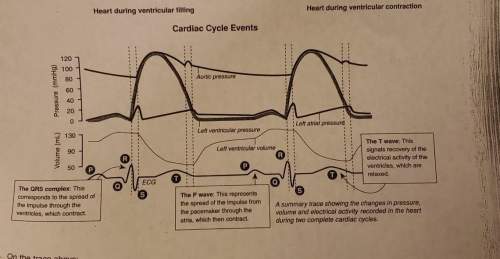
Biology, 22.11.2019 08:31, babysisjessica1
Using the letters indicated, mark the points on trace above corresponding to each of tbe following:
a) e: ejectjon of blood from the ventricle
b) bvc: closing of the bicuspid valve
c) fv: filling of the ventricle
d) bvo: opening of the bicuspid valve


Answers: 1
Other questions on the subject: Biology

Biology, 21.06.2019 14:30, auntlynard1843
Often, caries will develop in an area of the tooth that's not readily accessible. which cavity preparation form defines this? a. retention b. resistance c. outline d. convenience
Answers: 1

Biology, 21.06.2019 19:30, jessiereyes2924
Name the following: (a) category of pathogen that causes diseases, like common cold and mumps. (b) the microorganism that requires a host to produce.
Answers: 2

Biology, 21.06.2019 20:30, ivetter5333
Autotrophs a. consume their food to get energy b. may use photosynthesis to gain energy c. are also called consumers d. cannot use solar energy
Answers: 2

Biology, 22.06.2019 00:30, loveagirl111puppy
On a recent expedition to a remote region of northern canada, scientists uncovered skeletal remains from about 100,000 years ago. surprisingly, all the skeletal remains, which included many species from differing biological families and spanned about two thousand years, showed evidence of experiencing temperatures in excess of 1000 degrees fahrenheit (or 538 degrees celsius). which of the following, if true, best explains the apparent paradox between the cold environment and the evidence of the bones experiencing hot temperatures? (a) chemical changes that naturally occur during the process of decay in only one north canadian species produce the same evidence of the species' skeletons being exposed to hot temperatures as the expedition scientists found. (b) a little over 103,000 years ago, a large fire is known to have occurred in northern canada. (c) strong evidence exists that as early as 70,000 years ago, homo sapiens around the world relied heavily on fire to cook animals. (d) in the same expedition and in roughly the same layer of excavation, scientists found rudimentary wood cutting and hunting tools used by early humans.
Answers: 3
Do you know the correct answer?
Using the letters indicated, mark the points on trace above corresponding to each of tbe following:...
Questions in other subjects:

Mathematics, 19.08.2019 21:30


History, 19.08.2019 21:30

Biology, 19.08.2019 21:30

Mathematics, 19.08.2019 21:30




Physics, 19.08.2019 21:30

Mathematics, 19.08.2019 21:30






